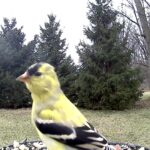So, as I’ve mentioned in some previous posts, the Eastern Towhee has been an infrequent visitor to our feeder area at best. I became interested in learning more about this bird, as I’ve seen at least one nearly every day for the last week. I was wondering, why are they hanging around here more now? I also was wondering why one of my older bird identification books listed the bird as the “Rufous Sided Towhee” and another book listed it as the Eastern Towhee.
For anyone who is unfamiliar with the Eastern Towhee, here is one image of a towhee at my bird feeder area recently.

So, naturally, I started with a google search for information on Towhee’s. I landed at one of my favorite sites for information on bird species, bird identification and birdwatching, the Cornell Lab of Ornithology. If you haven’t visited this great site, or if you haven’t participated in Project FeederWatch, please check it out. Anyways, their information on the Eastern Towhee is really fantastic. One of the most interesting things that I learned is that the Eastern Towhee is the “newer name”. Both the Eastern Towhee and the western Spotted Towhee used to be known as the Rufous Sided Towhee (prior to 1995). I’m glad that I wasn’t crazy in thinking that this bird was a “Rufous Sided Towhee”!
I also learned that this bird really enjoys loose edges, the leaf covered edges of the forest, and areas where there is a lot of scrub brush. That basically describes our backyard feeder environment to a tee! I can’t believe we weren’t seeing these birds more often!
I learned that population of the Eastern Towhee has been declining due to surburban sprawl. Let’s face it, most homeowners don’t care for loose edges and lots of leaf litter on the ground. It makes me happy that we are able to provide a suitable habitat for these little guys. My new goal is to try and get a video of their backward hop. They scratch with both feet through the leaf litter and make a LOT of noise and commotion sometimes doing this. It is one of the easiest ways for me to spot them. Sometimes they are just thrashing about in the edge of the woods behind our red shed. Seeing the Eastern Towhee practicing this foraging behavior is birdwatching at its best.
I’ve been having a lot of fun photographing these small ground dwelling birds, so check out our online photo gallery for lots more pictures.
I’m very excited about the possibility of this Eastern Towhee nesting in our area. It will be great to add this bird to our list of “daily visitors”. They are quite fun to watch and listen to.




